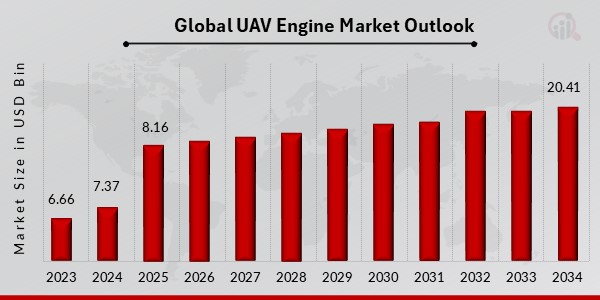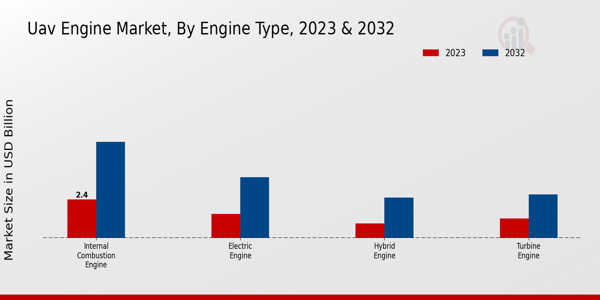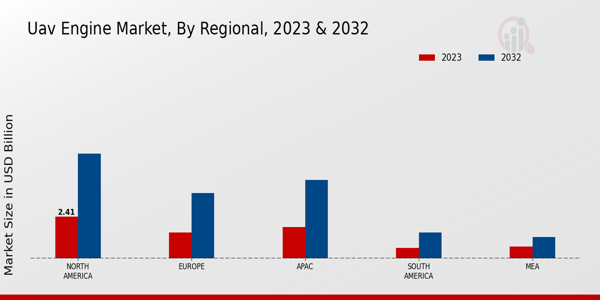Global UAV Engine Market Overview
The UAV Engine Market Size was estimated at 7.37 (USD Billion) in 2024. The UAV Engine Market is expected to grow from 8.16 (USD Billion) in 2025 to 20.41 (USD Billion) by 2034. The UAV Engine Market CAGR (growth rate) is expected to be around 10.7% during the forecast period (2025 - 2034).

Source: Primary Research, Secondary Research, MRFR Database and Analyst Review
Key UAV Engine Market Trends Highlighted
Technological developments, the growing need for surveillance, and the expanding acceptance of both commercial and military applications are the main drivers of the worldwide UAV engine market. Drones are becoming more and more necessary for monitoring, law enforcement, and delivery services, among other applications.
Additionally, the development of different UAV models is being encouraged by advancements in engine efficiency and compactness. Manufacturers are innovating as a result of this increased interest, producing engines that are not only more efficient but also able to suit a variety of operational needs.
The industry offers a wide range of opportunities, especially as sectors investigate the use of UAVs in emergency response, logistics, and agriculture.
The integration of artificial intelligence and machine learning into drone operations presents new possibilities for enhanced capabilities. Furthermore, the increasing recognition of the benefits of using UAVs for environmental monitoring and disaster management can lead to expanded adoption and investment in the UAV engine sector.
As regulatory frameworks evolve, they may create additional pathways for market growth, allowing newcomers and established players to collaborate effectively in unleashing new innovations.
Recent trends show a shift towards greener technologies and sustainable practices in UAV engine design. There is a growing emphasis on developing hybrid and electric propulsion systems that aim to reduce the carbon footprint of drone operations.
Furthermore, as urban air mobility gains traction, the demand for more compact and lightweight engines is becoming increasingly significant. The potential for cross-industry applications, such as integrating UAVs into public transport systems, further highlights the evolving nature of the market.
Overall, the UAV Engine Market is positioned for significant growth as stakeholders embrace technological advancements and new operational paradigms.
UAV Engine Market Drivers
Increasing Adoption of UAVs Across Various Industries
The UAV Engine Market is witnessing a significant shift as various sectors increasingly adopt unmanned aerial vehicles (UAVs) for a multitude of applications. This transition is largely driven by the need for improved efficiency, cost-effectiveness, and enhanced operational capabilities.
Industries such as agriculture, defense, logistics, and environmental monitoring are leveraging UAVs to gain competitive advantages. In agriculture, for instance, UAVs facilitate precision farming techniques, enabling farmers to monitor crop health, optimize irrigation, and minimize pesticide usage.
In the defense sector, UAVs play a critical role in reconnaissance and surveillance missions, offering strategic operational advantages while keeping personnel safe. The logistics industry is also experiencing a transformation with the integration of UAVs for last-mile deliveries, significantly reducing delivery times and operational costs.
This growing trend across multiple industries not only augments the demand for advanced UAV engines but also drives innovation, resulting in the development of more efficient and powerful propulsion systems.
As a result, the increased adoption of UAVs acts as a substantial market driver, contributing to a marked expansion of the UAV Engine Market.
Technological Advancements in UAV Engines
Technological advancements in UAV engines are playing a pivotal role in propelling the UAV Engine Market forward. The constant evolution of engine technologies, including electric propulsion systems and hybrid engines, is enhancing the performance and efficiency of UAVs.
Innovations in battery technology are extending flight times, enabling UAVs to cover greater distances and perform more demanding tasks. Furthermore, advancements in materials science are leading to lighter and more durable engine components, resulting in improved fuel efficiency and reliability.
The integration of advanced control systems further optimizes engine performance, ensuring that UAVs operate at peak efficiency under varying conditions. As these technologies continue to mature, they are opening up new possibilities for UAV applications, thereby bolstering market growth.
Growing Investments in Military and Defense
The military and defense sector is increasingly recognizing the strategic advantages offered by UAVs, leading to a surge in investments in this area. Governments are allocating substantial budgets to enhance their aerial capabilities, focusing on developing advanced UAV systems equipped with sophisticated engines.
The demand for surveillance, reconnaissance, and logistical support in military operations is driving the need for more reliable and powerful UAV engines.
As defense forces adopt modern technologies to bolster operational capabilities, the UAV Engine Market is expected to flourish, fueled by these substantial investments.
UAV Engine Market Segment Insights
UAV Engine Market Engine Type Insights
The UAV Engine Market gained substantial traction, influenced by the growing demand for versatile and efficient propulsion systems in unmanned aerial vehicles (UAVs). Analyzing the Engine Type segment showcased distinct differentiation among the diverse technologies employed, with Internal Combustion Engines, Electric Engines, Hybrid Engines, and Turbine Engines contributing to the overall market dynamics.
The Internal Combustion Engine held a majority share in the market with a valuation of 2.4 USD Billion in 2023 and is projected to grow to 6.0 USD Billion by 2032. This sub-segment was pivotal due to its established technology, relative cost-effectiveness, and extensive application in mid to large UAV platforms, often required for longer flight durations and heavier payload capacities.
On the other hand, the Electric Engine segment experienced notable growth, valued at 1.5 USD Billion in 2023 and expected to reach 3.8 USD Billion in 2032. The increasing emphasis on sustainability and reduced carbon emissions is driving the adoption of electric propulsion systems, which are well-suited for smaller UAVs commonly used in surveillance, mapping, and recreational applications.
Moreover, with the rapid advancement in battery technology, the Electric Engine is becoming increasingly competitive, making it significant in shaping future UAV operations.
The Hybrid Engine, valued at 0.9 USD Billion in 2023 and projected to expand to 2.5 USD Billion by 2032, served as an innovative solution, combining both internal combustion and electric systems to optimized fuel efficiency and extend operational range as UAV applications diversifiedy from military operations to commercial delivery systems the Hybrid Engine is gaining traction for its versatility in adapting to various mission profiles.
Lastly, the Turbine Engine accounted for 1.2 USD Billion in 2023, anticipated to rise to 2.7 USD Billion by 2032. This engine type is crucial for larger UAV systems, predominantly utilized in defense and high-end commercial applications where high power-to-weight ratios and the ability to operate at various altitudes are essential. The growth of the Turbine Engine segment reflected the expanding need for advanced UAVs capable of undertaking complex missions, driving demand in both military and civilian sectors.
Overall, the UAV Engine Market segmentation across Engine Types illustrated varying growth trajectories and importance, highlighting the dynamic interplay between technological advancements and market demands, shaping the future landscape of unmanned aerial systems.

Source: Primary Research, Secondary Research, MRFR Database and Analyst Review
UAV Engine Market End Use Insights
The UAV Engine Market is witnessing significant growth, particularly across various end-use applications, including military, commercial, industrial, and civil sectors. Each segment plays a vital role; for instance, the military sector is a major contributor, driven by the increasing defense budgets and the rising demand for advanced surveillance capabilities.
The commercial sector is also gaining traction with applications in delivery services and agriculture, thereby presenting notable growth opportunities.
The industrial end-use segment benefits from UAVs used in infrastructure inspections and monitoring, while civil applications, including environmental monitoring and disaster management, increasingly dominate due to their utility in enhancing public safety. The diverse range of applications contributes significantly to the UAV Engine Market revenue and reflects a notable trend toward innovation and technology integration.
Market growth is further supported by factors such as regulatory advancements and the ongoing development of autonomous flight systems, presenting opportunities to address challenges like airspace congestion and operational conditions.
Overall, the UAV Engine Market segmentation highlights the critical importance of each end-use category in shaping the industry's future landscape.
UAV Engine Market Power Output Insights
The UAV Engine Market showcases a diverse landscape segmented by power output. The market's design includes categories like Less than 50 HP, 50-100 HP, 100-200 HP, and Above 200 HP, each catering to different operational requirements and applications.
The power output of less than 50 HP holds a significant share, primarily utilized in smaller UAVs for tasks such as aerial mapping and surveillance, reflecting trends toward miniaturization and fuel efficiency.
Meanwhile, engines in the 50-100 HP range are essential for versatile mid-sized UAVs, offering a balance between power and efficiency suitable for commercial and military applications.
In contrast, the 100-200 HP category is gaining traction as it supports heavier payloads, making it crucial for industries like agriculture and logistics. The Above 200 HP segment caters to larger UAVs used in high-demand sectors such as defense and cargo transport, demonstrating increased capabilities and technological advancements.
UAV Engine Market Application Insights
The application segment of the market plays a crucial role in shaping its dynamics, with significant contributions from industries such as Surveillance, Transportation, Agriculture, and Mapping. Surveillance applications dominate this segment due to the growing need for security and monitoring solutions in urban and rural environments.
Transportation applications are witnessing robust growth as UAVs offer efficient logistics and delivery systems, responding to the increasing demand for rapid transport solutions.
Agriculture also holds a notable position, as UAVs enhance crop monitoring, precision agriculture, and pest control, driving operational efficiency and sustainability. Mapping applications leverage UAV technology for topographic surveys and geological assessments, facilitating data collection that is vital for planning and development projects.
The market growth across these applications reflects a broader trend of increasing investment in UAV technologies and solutions, driven by advancing technology and regulatory support, highlighting the diverse opportunities inherent within the UAV Engine Market segmentation.
UAV Engine Market Regional Insights
The UAV Engine Market exhibits significant growth potential across various regions. The North American segment dominated the market, valued at 2.41 USD Billion, and is projected to expand to 6.02 USD Billion by 2032, highlighting its majority holding due to advanced technological innovations and substantial defense expenditure.
Europe's valuation stood at 1.5 USD Billion as of 2023, with expectations to reach 3.75 USD Billion, driven by rising applications in commercial UAVs. The APAC region, valued at 1.8 USD Billion, is set to grow to 4.5 USD Billion, primarily due to increasing demand for aerial surveillance and security operations.
South America and MEA were smaller segments, valued at 0.6 USD Billion and 0.7 USD Billion in 2023 respectively, with potential for growth as UAV technology gains acceptance for agricultural and monitoring purposes.
Overall, the UAV Engine Market segmentation reveals distinct regional dynamics, where North America led, followed by Europe and APAC, indicating diverse market trends and growth drivers specific to each geopolitical area.

Source: Primary Research, Secondary Research, MRFR Database and Analyst Review
UAV Engine Market Key Players and Competitive Insights
The UAV Engine Market is characterized by a dynamic and rapidly evolving landscape influenced by technological advancements, regulatory environments, and increasing demand from various sectors such as defense, aerospace, and commercial applications.
As the market continues to expand, competition is intensifying among key players striving to innovate their offerings and capture a larger share of the burgeoning demand for unmanned aerial vehicles. Companies are increasingly focusing on developing high-performance, efficient, and versatile engine solutions to cater to the diverse operational requirements of UAVs.
Factors such as the increasing adoption of UAVs for surveillance, reconnaissance, and cargo delivery applications are further propelling the market, prompting industry participants to refine their strategies to maintain competitiveness and achieve growth targets.
Thales Group has established itself as a formidable player in the UAV Engine Market through its commitment to innovation and technological advancement. The company leverages its robust research and development capabilities to design cutting-edge engine solutions that cater to a broad spectrum of UAV applications.
Thales Group's strengths lie in its ability to integrate advanced technologies, including artificial intelligence and enhanced communication systems, into its UAV engine offerings, which not only enhances performance but also provides significant operational advantages. With a strong focus on reliability and efficiency, Thales Group has developed engines that are recognized for their capability to withstand rigorous operational conditions.
Moreover, the company's strategic collaborations with key industry stakeholders bolster its presence in various regional markets, allowing it to respond effectively to the evolving demands of UAV operators and ensure sustained growth in this competitive landscape.
GKN Aerospace is another significant contender in the UAV Engine Market, recognized for its engineering expertise and innovation-driven approach. The company specializes in providing lightweight, high-performance engine components that enhance UAV capabilities across various missions.
GKN Aerospace has optimized its manufacturing processes to ensure the production of engines that deliver superior performance while addressing sustainability challenges. Their extensive experience in aerospace engineering allows them to create tailored solutions that meet the specific requirements of various UAV models.
GKN Aerospace's commitment to fostering partnerships with defense and aerospace sectors further strengthens its market position, enabling the company to stay ahead of technological trends and customer expectations.
By focusing on continuous improvement and addressing the challenges faced by UAV operators, GKN Aerospace is well-positioned to maintain a competitive edge in the evolving UAV Engine Market.
Key Companies in the UAV Engine Market Include
- Thales Group
- GKN Aerospace
- Rolls-Royce
- Dynetics
- BAE Systems
- Honeywell Aerospace
- Raytheon Technologies
- UTC Aerospace Systems
- L3 Harris Technologies
- AeroVironment
- Northrop Grumman
- General Atomics
- Kaman Corporation
- Elbit Systems
- Textron Systems
UAV Engine Market Developments
The UAV Engine Market has recently experienced significant developments, particularly among key players like Thales Group, Rolls-Royce, Honeywell Aerospace, and Northrop Grumman.
In the wake of growing defense budgets, there has been a notable increase in demand for advanced UAV systems, which has positively influenced the market valuation of these companies. For instance, Honeywell Aerospace recently announced enhancements to its UAV engine offerings, focusing on increased efficiency and reduced emissions, a trend echoed by GKN Aerospace and BAE Systems as well.
Additionally, mergers and acquisitions are shaping the landscape; Thales Group's acquisition of a prominent UAV technology firm has strengthened its market position, while Dynetics' expansion strategy includes collaboration with various defense partners.
The alignment of technological advancements with military needs has further fueled growth in this sector. The rise in UAV applications in civilian sectors like agriculture and surveillance is also a significant driver, leading to increased innovation and partnerships, particularly among companies like AeroVironment and Elbit Systems.
Overall, these factors contribute to a dynamic market environment, reflecting the importance of UAV technologies in both defense and commercial applications.
- UAV Engine Market Segmentation Insights
- UAV Engine Market Engine Type Outlook
- Internal Combustion Engine
- Electric Engine
- Hybrid Engine
- Turbine Engine
- UAV Engine Market End Use Outlook
- Military
- Commercial
- Industrial
- Civil
- UAV Engine Market Power Output Outlook
- Less than 50 HP
- 50-100 HP
- 100-200 HP
- Above 200 HP
- UAV Engine Market Application Outlook
- Surveillance
- Transportation
- Agriculture
- Mapping
| Report Attribute/Metric |
Details |
| Market Size 2024 |
7.37 (USD Billion) |
| Market Size 2025 |
8.16 (USD Billion) |
| Market Size 2034 |
20.41 (USD Billion) |
| Compound Annual Growth Rate (CAGR) |
10.7% (2025 - 2034) |
| Report Coverage |
Revenue Forecast, Competitive Landscape, Growth Factors, and Trends |
| Base Year |
2023 |
| Market Forecast Period |
2025 - 2034 |
| Historical Data |
2019 - 2023 |
| Market Forecast Units |
USD Billion |
| Key Companies Profiled |
Thales Group, GKN Aerospace, Rolls-Royce, Dynetics, BAE Systems, Honeywell Aerospace, Raytheon Technologies, UTC Aerospace Systems, L3 Harris Technologies, AeroVironment, Northrop Grumman, General Atomics, Kaman Corporation, Elbit Systems, Textron Systems |
| Segments Covered |
Engine Type, End Use, Power Output, Application, Regional |
| Key Market Opportunities |
Rising defense budgets globally, Increasing civilian applications, Technological advancements in propulsion, Growth of e-commerce deliveries, Expanding agricultural UAV usage |
| Key Market Dynamics |
Technological advancements in propulsion, Increasing defense expenditures globally, Growing demand for commercial applications, Sustainability and environmental regulations, Rising investments in UAV R |
| Countries Covered |
North America, Europe, APAC, South America, MEA |
Frequently Asked Questions (FAQ) :
The expected market size of the UAV Engine Market in 2034 is 20.41 USD Billion.
The projected CAGR for the UAV Engine Market between 2025 and 2034 is 10.7%.
North America is expected to hold the largest market share in the UAV Engine Market by 2032, valued at 6.02 USD Billion.
The market value of Internal Combustion Engines in the UAV Engine Market is expected to reach 6.0 USD Billion by 2032.
Key players in the UAV Engine Market include Thales Group, GKN Aerospace, RollsRoyce, and Honeywell Aerospace, among others.
The expected market size for Electric Engines in the UAV Engine Market by 2032 is 3.8 USD Billion.
The market for Turbine Engines in the UAV Engine Market is expected to grow to 2.7 USD Billion by 2032.
The value of the UAV Engine Market in the APAC region is projected to reach 4.5 USD Billion by 2032.
The expected market value for Hybrid Engines in the UAV Engine Market by 2032 is 2.5 USD Billion.
Emerging trends such as increased defense spending and advancements in technology present significant growth opportunities in the UAV Engine Market.

















